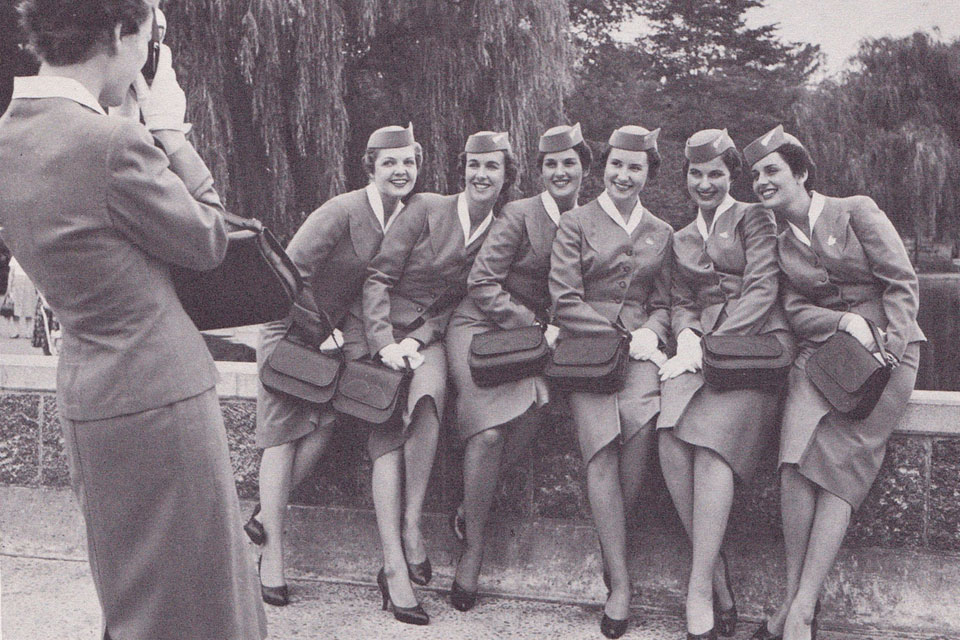
What It Used to Be Like: Being a Flight Attendant
There are a lot of myths and stereotypes that surround flight attendants. For example, it is believed that they have to go through casting, just like models, or don’t have the right to get married (which was, by the way, true at some point). Flight attendants have been around for 85 years, and in this time attitudes towards them has changed from respectful and filial to light-minded and friendly.
The First Flight Attendants
It was a woman who came up with the idea of an assistant on a civil plane. In 1930, a San Francisco nurse, Ellen Church, came to offices of Boeing Air Transport (now United Airlines) and suggested to the manager, Steve Stimpson, that he employ her as an assistant during a flight. By that time the transport companies were ready to equip their planes with stewards to enhance comfort and passenger care. It did not take long to choose between women and men. To give perspective, the main clients of passenger flights were businessmen – and they did not to change from trains to planes as they were afraid of crashes. But with a sympathetic and fearless nurse on board – why not fly? The image of a female medical professional made the aerophobes feel so calm and sure that they forgot one would hardly need the nurse’s skills in an airplane crash.
May 15, 1930 started the stewardess era – a group of eight nurses headed by Ellen Church attended to passengers of the San Francisco – Chicago flight. After the experiment was deemed successful, other companies followed the example of United Airlines and started hiring certified nurses to fly with them: not older than 25, not higher than 160cm and weighing less than 52 kg.
The duties of the stewardess were not only to bring tea or coffee, but also to handle baggage, punch tickets, check that the chairs were fixed to the floor well and that the fuel didn’t get into the passenger cabin, keep the cabin clean, wash the floors and the passenger cabin windows, made sure that the passenger doesn’t confuse the emergency exit for the toilet door during the flight, and kept a train schedule at hand, in case the plane landed in the middle of nowhere.
{“img”: “/wp-content/uploads/2015/07/stu_23.jpg”, “alt”: “”, “text”: “Boeing Air Transport flight attendants are ready for inspection, 1930.”}
{“img”: “/wp-content/uploads/2015/07/stu_22.jpg”, “alt”: “”, “text”: “Flight attendants Ellen Church and Virginia Schroeder posing in front of a plane, May 14, 1940.”}
Advertising Tool
During WWII many women with a medical education were called to the front. Airlines discovered that one does not necessarily need nurse training to take care of the passengers. The industry itself has changed – competing airlines had an equal level of technology and safety, and therefore, to attract clients they needed to build a new attractive image of the flight attendant.
The women on board became central in advertisement campaigns. Drew Whitelegg who wrote «Working the Skies: The Fast-Paced Disorienting World of the Flight Attendant» says that the stewardesses turned from medical professionals to a live guarantee of a comfortable flight and quality service on board. Wealthy men were still the main clients on flights, so the work of the stewardess bore certain resemblances to the work of a mother and a caring wife. The idea that the airlines planted in the heads of the passengers started bearing fruit – stewardesses now became desirable brides, but they were prohibited from getting married by their contract with the company. To get married, they had to give up the job they loved, and the airlines fell in their own trap and had to deal with constant staff turnover.
{“img”: “/wp-content/uploads/2015/07/stu_01.jpg”, “alt”: “”, “text”: “Flight attendant training, 1960. Photo by Jack Engemann.”}
{“img”: “/wp-content/uploads/2015/07/stu_02.jpg”, “alt”: “”, “text”: “Flight attendants, 1960. Photo by Jack Engemann.”}
{“img”: “/wp-content/uploads/2015/07/stu_03.jpg”, “alt”: “”, “text”: “Flight attendant training, 1960. Photo by Jack Engemann.”}
{“img”: “/wp-content/uploads/2015/07/stu_05.jpg”, “alt”: “”, “text”: “Delta Airline employees, 1960. Photo from Jack Engemann’s book.”}
The Golden Age of Stewardesses
The image of the stewardess gradually transformed from motherly to sexual. Guillaume de Syon, a professor at Pennsylvania’s Albright College and an expert on aviation history, says, it was boring to fly in the 60-s as the passengers had little in-flight entertainment. On board they wrote postcards, chatted with their neighbours, smoke and drank. There were limits on alcohol consumption, so the passengers often got drunk and hit on the stewardesses.
This led to a struggle for more respect for women and the development of the profession. The flights attendants opposed sexism that books like Coffee, Tea or Me? – The Uninhibited Memoirs of Two Airline Stewardesses surrounded them with. They drew the attention of society to the fact that they were on board for the safety of the passengers not for their sexual gratification. The Civil Rights Act of 1964 that outlawed discrimination based on race, sex and religion at the workplace encouraged women to fight with the ban on getting married, demand the opportunity to develop their career, and not retire at 32.
The popularity of civil aviation and globalization led to airlines all over the world establishing their own general standards and demands for their employees. Since the 70’s the stewardesses have been allowed to get married and have children with no harm to their career. Their uniforms are not that revealing anymore, and they are referred to as flight attendants now.
{“img”: “/wp-content/uploads/2015/07/stu_15.jpg”, “alt”: “”, “text”: “Pacific Southwest Airlines flight attendants in 1973 uniform.”}
{“img”: “/wp-content/uploads/2015/07/stu_25.jpg”, “alt”: “”, “text”: “Delta Airlines stewardess, circa 1968-1970.”}
{“img”: “/wp-content/uploads/2015/07/stu_26.jpg”, “alt”: “”, “text”: “American Airlines employees, the beginning of 1970-s.”}
Photo: San Diego Air & Space Museum archives.
New and best




